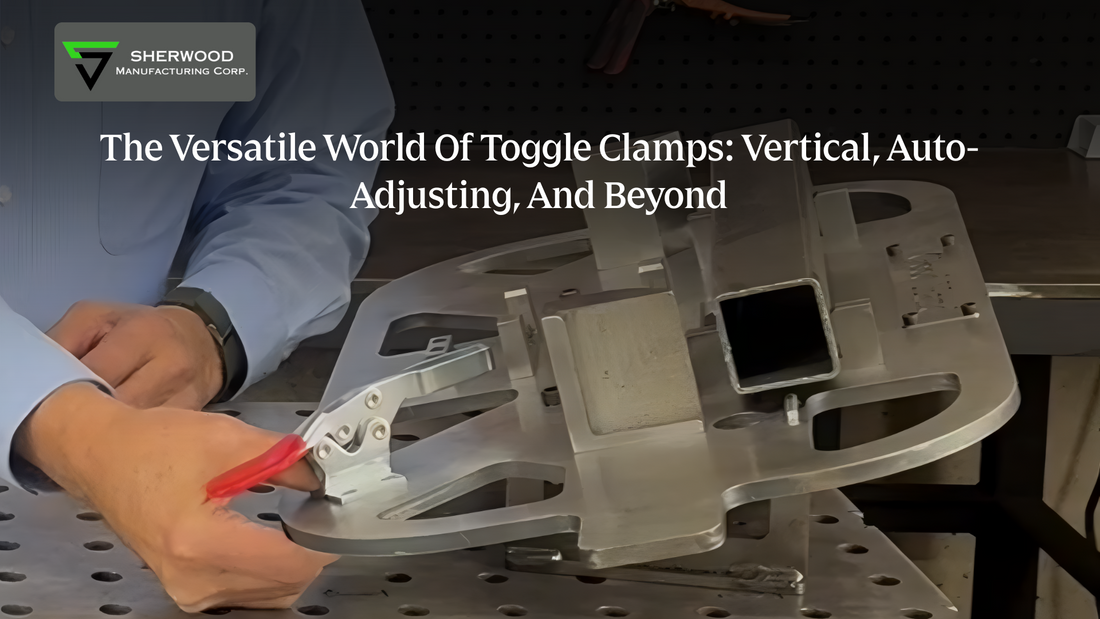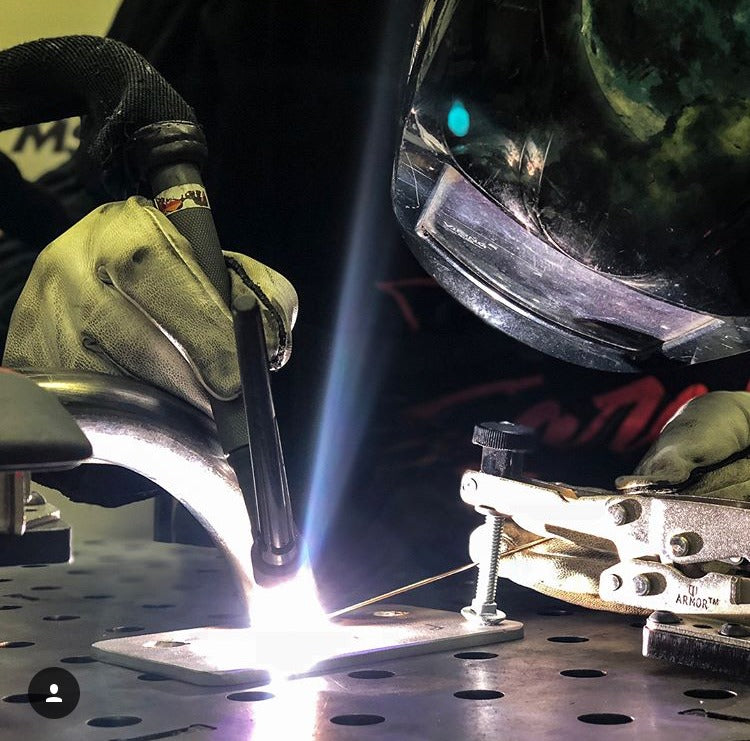
The Versatile World Of Toggle Clamps: Vertical, Auto-Adjusting, And Beyond
Share
Why Toggle Clamps Matter in Modern Manufacturing
Imagine a busy factory floor. Machines hum, sparks fly, and workers move with purpose. In this world, every second counts. Mistakes are costly. Precision is everything.
Now, think about what holds all those parts in place, what keeps workpieces steady during welding, assembly, or cutting. The answer is often simple but powerful: toggle clamps.
Toggle clamps are the unsung heroes of manufacturing and fabrication. They are small, sturdy devices that make a big difference. In fact, over 70% of small manufacturing shops rely on toggle clamps for precision and speed.
But what makes these clamps so important? How do they work? And what types are best for your needs?
This guide explores the many faces of toggle clamps. You’ll learn about their types, features, and real-world uses. Whether you’re new to manufacturing or a seasoned engineer, you’ll discover how the right toggle clamp can boost productivity, safety, and efficiency.
What Is a Toggle Clamp?
A toggle clamp is a mechanical device that holds objects firmly in place. It uses a simple lever and pivot system to create a strong, secure grip.
Toggle clamps are used in many industries, from woodworking and metal fabrication to electronics and automotive assembly.
Key Parts of a Toggle Clamp
• Lever: The handle you push or pull to lock or release the clamp.
• Arm: The part that presses down on the workpiece.
• Clamp: The movable jaw or pad that makes contact with the object.
• Base: The sturdy platform that attaches to a workbench or fixture.
How Do Toggle Clamps Work?
Toggle clamps use a clever mechanism. When you move the handle, the arm pivots and locks into place. This action creates a strong holding force. The clamp stays locked until you release the handle.
This quick, reliable action makes toggle clamps perfect for jobs that need fast setup and repeatable results.
Types of Toggle Clamps: Finding the Right Fit
Toggle clamps come in many shapes and sizes. Each type has its own strengths.
• Vertical Toggle Clamps: Both handle and arm move up and down; the handle locks into place with an upward motion.
• Horizontal Toggle Clamps: Both handle and arm move up and down; the handle locks into place with a downward motion, parallel to the base and keeping a low profile while saving space.
• Push-Pull Toggle Clamps: The arm moves in and out, ideal for holding objects from the side.
• Auto-adjusting clamps: The clamp instantly adapts to variations in workpiece height or thickness, so you don’t need to stop and readjust for each new piece
• Differences in Design and Use: Some clamps are fixed in place, while others are adjustable. Some have open arms for flexibility; others have solid arms for extra strength.
The right choice depends on your project, the size of your workpiece, and how much force you need.
The Benefits of Toggle Clamps in Manufacturing
Why do so many factories and workshops rely on toggle clamps? Here are the main reasons:
1) Speed and Efficiency
Toggle clamps lock and release quickly. This saves time during setup and changeovers.
In some cases, using toggle clamps can reduce setup times by up to 40%. That means more parts made in less time.
2) Safety and Reliability
A secure clamp keeps workpieces from slipping or shifting. This reduces the risk of accidents and ensures consistent results.
As one welding specialist puts it, “These clamps provide consistent pressure, ensuring safe, repeatable results.”
3) Versatility and Flexibility
Toggle clamps work with many shapes and sizes. They are easy to adjust or reposition, making them perfect for custom jobs and batch production.
4) Cost Savings
Faster setups mean lower labor costs. Reliable clamping reduces tool wear and damage. Over time, investing in quality toggle clamps pays off.
Exploring Vertical Toggle Clamps
Vertical toggle clamps are designed for jobs where downward force is needed. The handle moves up and down, pressing the arm straight onto the workpiece.
This design is perfect for holding items flat on a table or fixture.
When to Use Vertical Clamps
Vertical clamps are ideal for:
• Securing workpieces on flat surfaces
• Welding jigs and assembly lines
• Tasks that need strong downward pressure
Case Study: Vertical Toggle Clamps in the Automotive Industry
In auto manufacturing, precision is key. During welding, even a small shift can mean costly rework.
A leading automotive plant switched to vertical toggle clamps on its welding jigs. The result?
• Overall productivity improvement is 28%
• Weld quality improved
• Worker safety increased
Vertical toggle clamps made it easy to lock parts in place, even during high-volume production.
What Makes Auto-Adjusting Clamps Different?
Auto-adjusting toggle clamps are a game-changer. Unlike standard clamps, they can grip objects of different sizes without manual adjustment.
This is possible thanks to a built-in mechanism that senses and adapts to the workpiece.
Advantages of Auto-Adjusting Design
• Saves Setup Time: No need to stop and readjust for each part.
• Handles Irregular Shapes: Perfect for parts with varying thickness or size.
• Ideal for Batch Production: Keeps the line moving, even when parts change.
Use in Electronics Manufacturing
Electronics factories often handle circuit boards of different sizes.
Auto-adjusting toggle clamps make it easy to switch between boards without slowing down the line.
This reduces assembly line downtime and boosts productivity.
Beyond the Main Types: Specialized Toggle Clamps: Not all jobs are the same. Sometimes, you need a clamp for a unique task. That’s where specialized toggle clamps come in.
Heavy-Duty Toggle Clamps: For heavy machinery and metal fabrication, strength is a must. Heavy-duty toggle clamps can withstand higher forces and hold large, heavy workpieces securely.
Choosing the Right Toggle Clamp: What to Consider
• Material and Durability: Choose clamps made from strong materials like steel or aluminum. This ensures long life and resistance to rust or corrosion.
• Clamping Force Required: Make sure the clamp can handle the force needed for your job.
• Space Limitations: Pick a clamp that fits your workspace and workpiece size.
Actionable Steps
• Test clamps regularly to ensure they hold securely.
• Match the clamp style to your workpiece shape and size.
• Use adjustable models for jobs with changing requirements.
Real-World Applications: Toggle Clamps in Action
External Threaded Bolt Retainer, for solid arm clamps. Designed so you can cut off the top of the spindle to protect your hand from being hit. Toggle clamps are everywhere in modern manufacturing. Here are some real-world examples:
1) Welding Products and Fixtures
In welding, a steady hold is vital. Many shops use welding toggle clamps to keep parts in place during welding.
For more options, explore the horizontal toggle clamps category, which offers a range of styles for different welding needs.
2) Toggle Clamp Accessories and Attachments
To get the most from your clamps, consider using toggle clamp accessories.
These include items like solid arm attachments and mounting blocks, which make clamps more versatile and easier to use.
How to Maintain and Use Toggle Clamps for Best Results
• Clean clamps regularly to remove dust and debris.
• Lubricate moving parts to prevent sticking.
• Inspect for signs of wear, such as loose bolts or bent arms.
• Replace worn parts promptly to avoid accidents.
Frequently Asked Questions About Toggle Clamps
• What is the main purpose of a toggle clamp?
A toggle clamp holds workpieces securely in place during manufacturing tasks like welding, cutting, or assembly. Its lever-action design makes it quick and easy to use.
• Can toggle clamps be used for both light and heavy-duty work?
Yes. There are many types of toggle clamps, from mini clamps for small jobs to heavy-duty clamps for large, heavy parts.
• How do I choose the right toggle clamp for my project?
Consider the size and shape of your workpiece, the required clamping force, and the space available.
Quality, adjustability, and compatibility with your fixtures are also important.
• What are toggle clamp accessories?
Toggle clamp accessories are add-ons that make clamps more versatile. Examples include solid arm attachments, mounting blocks, and open arm attachments.
• Are toggle clamps safe to use?
When used correctly, toggle clamps are very safe. They reduce the risk of workpieces slipping and help prevent accidents.
The Future of Toggle Clamps in Manufacturing
Toggle clamps may look simple, but they are essential tools in modern manufacturing. From vertical and auto-adjusting styles to specialized, there is a toggle clamp for every need. By choosing the right clamp, using quality accessories, and following best practices, you can boost productivity, improve safety, and save money.
As technology and manufacturing needs evolve, having a reliable partner for your clamping and fixturing solutions becomes even more important. That’s where Sherwood Manufacturing stands out. With decades of experience and a commitment to innovative, precision-engineered products, Sherwood can offer welding product solutions and toggle clamp accessories
Whether you’re upgrading your assembly line, improving welding processes, Sherwood Manufacturing provides the expertise and quality you can trust. Explore their categories to discover how the right clamping solutions can make your shop safer, more efficient, and ready for the future. designed to meet the demands of today’s industrial environments.

